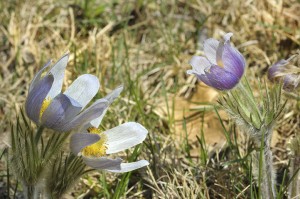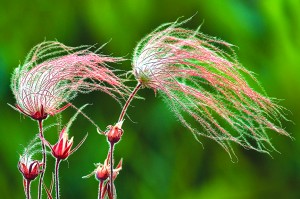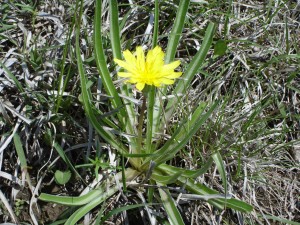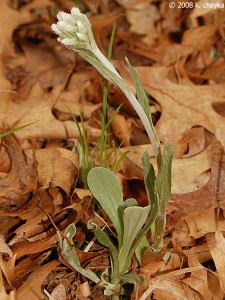What's in Bloom: Early Spring
By Catherine Wilson on March 25, 2015 in Blog
This is our first installment of “What’s in Bloom.” From time to time, INHF volunteer Catherine Wilson will let you know about native plants that are in bloom around Iowa.
As incredible as 60-degree weather feels in early March, think about the opportunity this warmth provides tender prairie flower seedlings. Despite the recent cold snap, there are still plants that can be found blooming around Iowa.
-

Pasque flowers are noted for their purple, blue or white sepals that appear to be pedals. Photo credit: Gary Tonhouse.
Pasque flowers (Anemone patens) bloom in March and April and grow 2 to 16 inches tall. The hairy, gray-green stems grow nearly erect from a thick, horizontal rootstock and a single, large flower emerges from the tip of a long flowerstalk. Though the flowers do not have true petals, they produce five to seven blue, purple or white sepals that form a flower about one-inch across and up to 1-1/2 inches long. Pasque flowers are broadcast by wind energy. American Indians used crushed leaves of Pasque flowers for the treatment of rheumatism, boils, burns and sore eyes. Other common names were April fool, prairie smoke, hartshorn, wild crocus and wind flower.1

Prairie smoke is in the rose family and is abundant on upland prairie sites. Photo credit: Gary Tonhouse.
Prairie smoke (Geum triflorum) bears its pink blossoms in early spring and grows equally well in sandy, loamy and clay soils though it prefers a well-drained site and full sun according to information posted on the Wisconsin Master Gardener site. This woodland flower is in the rose family and is abundant on upland prairie sites. The flowers can have as many a nine clusters of nodding reddish-pink, maroon or purple flowers on 12-18 inch stems. The plant forms a 6-10 inch cluster of foliage produced by 9-19 narrow, ferny leafs. The leaves turn red, purple and orange in late fall. Though the leaves wilt in full, hot sun, they emerge into a deep gray-green color in the cooler fall air. American Indians used an infusion of roots and crushed seed pods or pulverized roots as an eye wash, sore throat gargle, and as a tonic for menstrual cramps. Other common names are Old Man's Whiskers, Purple Avens and Three-Flowered Avens.

Prairie dandelion, also called goat chicory and false dandelion, blooms in April and May.
Prairie dandelion (Agoseris cuspidata) blooms from April through May in dry prairies and stony hills from Wisconsin to Montana. The perennial taproot produces narrow, grasslike leaves from four to eight inches long, and the yellow dandelion-like flower tops a stout, leafless stalk that may grow to one foot in height. The long, thin pedals radiate from the sepals and form a flower that is one to two inches across and one-inch high. The pedals have a five-toothed, ragged appearance at the tips and are less numerous than a common dandelion. The tender roots of the prairie dandelion were eaten raw by early settlers and the dark, milky juice that flows from a broken stalk – similar to rubber – was chewed by American Indians. Other names were goat chicory and false dandelion.1

Pusseytoes are also called everlasting and ladies' tobacco. Meskwaki women used the leaves to make tea to drink following childbirth.
Pusseytoes (Antennaira plantagini-folia) are low-growing perennials often found on rocky edges or dry, disturbed woodland sites and is a valuable soil anchor. Blooms decorate the landscape from late April to June. Several narrow leaves and a tight cluster of grayish flower heads emerge from the center of a base rosette and are covered with silky hairs. The gray appearance of the leaves look similar to a dusty rose and retain their color after being picked. Pusseytoes are unisexual and reproduction occurs by leaf-bearing stolons which allow dense colonies to form. Meskwaki women drank a tea produced from the leaves for two weeks after childbirth to prevent illness. Other common names are everlasting and ladies' tobacco.1
- Runkel, S. (2009). Wildflowers of the Tallgrass Prairie (Second ed., pp. 7-15). Iowa City, Iowa: University of Iowa Press.
